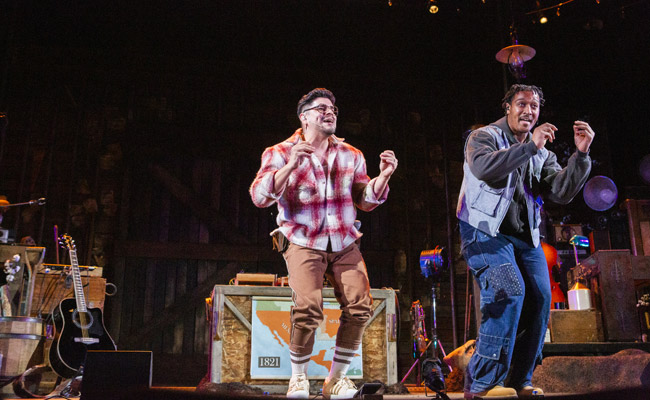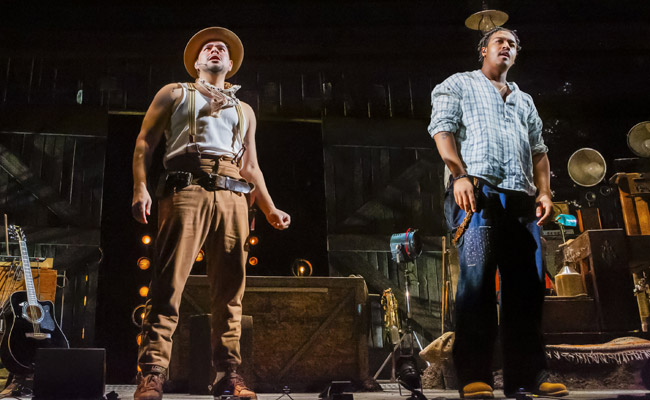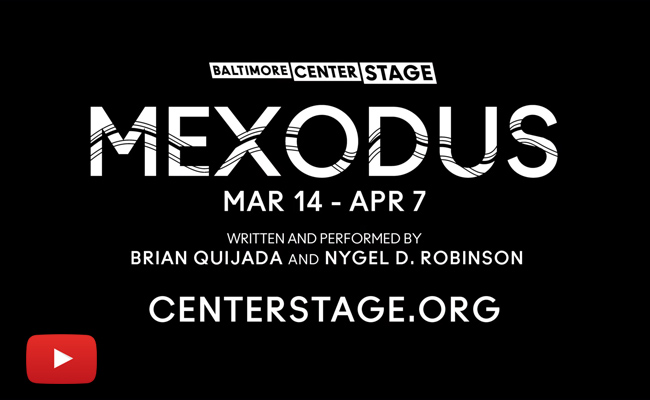
J Fannon Photography
It’s not often that one gets to experience a vibrant, new theatrical work because the process to create a new piece of theatre can take years of writing, rewriting, composing, having staged readings, more rewriting and tweaking, casting, rehearsing, and then tackling all the technical aspects from costumes to sets, lighting to sound. It’s a process and even to get past the writing stage also takes support of the monetary kind. These shows don’t just put themselves on. Coming up with a great idea can be the first stumbling block, finding something new to present to audiences, whether it’s a show to just purely entertain or one that has something to say as well as entertain. Shows that have a specific point of view are becoming urgently needed today as our society becomes more politically divided, especially when it comes to the history of this country that many would prefer to ignore, hide or erase. Finding something to say that isn’t just a retread of a previous production, and finding a way to present that subject matter to an audience in a way that will entertain and enthrall without leaving everyone feeling as if they’ve been hit over the head with a large hammer for two-plus hours is not for the faint of heart.
Luckily, playwrights/performers Brian Quijada and Nygel D. Robinson have uncovered a bit of history that very few Americans know about — the Underground Railroad. Sure, we all know about Harriet Tubman helping slaves find their way to freedom in the North, but what most of us don’t know is that the Underground Railroad also went South. South of the Border, more specifically. Imagine that … enslaved ‘Americans’ (only in that they lived in America while considered a separate class of persons) crossing the Southern border into Mexico to make a better life for themselves. The history of this is spotty with only sparse documentation, but it is a fascinating subject for a show that aims to not just educate audiences but make them think about how this bit of history relates to our world today.
Both Quijada and Robinson are the stars of Mexodus — the only two cast members — and they are an engaging pair. As the show begins they riff with the audience, giving a brief rundown of what it is exactly that they’re about to experience. With the introductions over, Robinson smoothly transitions into the character of Henry, an enslaved Black man accused of attempting to have ‘relations’ with his Master’s wife (it was she who tried to seduce him), nearly murdered for his actions but turning the tables and saving himself while beating his Master to death. Realizing things will not end well for him, even though it was self-defense, Henry has to go on the run, and being in the Deep South means heading North will be much too treacherous so he will head South as he’s heard others have done. There’s just one big problem — the Rio Grande river. Nearly drowning while attempting to cross, Henry is saved by Carlos (Quijada), a farmer on the other side of the river who nurses Henry back to health, but their relationship become complicated when Carlos learns that Henry is wanted for murder. They are also tested when a flash flood nearly destroys the farm, but Carlos still has to wrestle with the decision to turn Henry over to the Americans or help him find a path to freedom.
While the characters are fictional, the story is all too real and harrowing but Quijada and Robinson have taken such an original path to present this tale that it never becomes maudlin. Taking a few notes from Hamilton, the music is infused with that hip hop/pop music vibe that gets under your skin and into your soul, making it impossible for you to not tap your feet, clap your hands and sway in your seat (and they even invite you to get up and dance if you feel so moved). What truly sets this apart from anything else is the music. Using modern technology to tell this 200 year old story, the pair use all manner of instruments, noise-making objects, their hands, feet and sounds they make with their mouths, recording just a few notes or beats with each instrument or objects live, and using a machine that loops what they’ve played, creating a continuous, multi-layered, rich, orchestral track that they thing sing or rap to. It is one of the most electrifying experiences one can have at the theatre. Words really can’t describe just how innovative and exciting and utterly original this is, especially when it could all go so very wrong as they record the music and then have to hit various buttons on the floor around the stage to control the musical output. One wrong tap and it could go haywire, but the effect is simply spectacular.

J Fannon Photography
Robinson’s Henry gets the spotlight for the first half of the story and his performance is nothing short of magnificent, effortlessly commanding the stage, showing us Henry’s heart and his anger, all with a voice that is easily compared to John Legend’s. Robinson’s tone is smooth and his range is out of this world, and at one point when he sits down at the piano and plays with a minimal amount of the looping, it will give you goosebumps. Quijada also gets his moments to shine, playing a mean guitar (and accordion), with a voice that is at time much more deep and gruff, but no less commanding as he also relates Carlos’ story to Henry, learning that they may not be as different as they first seemed. The performances make the relationship between the two men authentic, and Quijada does keep you on the edge of your seat wondering if he’s going to turn Henry over to the men looking for him. These are two extremely talented gentlemen, both in their writing and performing, and I can easily see them taking this show from Baltimore to DC (where it will relocate after the limited run at Center Stage) and beyond.
On the technical side of things, the incredible set which looks like the interior of a barn stocked with all manner of instruments, audio equipment and other noise-making accoutrements, designed by Riw Rakkulchon and Laura Valenti, is a stationary affair (save for the barn doors that open at one point during a storm) with everything carefully laid out for the actors to grab an instrument, make some noise and create their loops, while still giving the appearance of things just being placed randomly around the room. The set is beautifully highlighted by Mextly Couzin’s and Christian Henrriquez’s lighting design, and Mikhail Fiksel’s sound design (with audio engineer Simon Briggs) allows us to hear every note, every word with beautiful clarity. David Mendizábal’s direction is flawless as they don’t just move the actors across the stage from point A to B to C, but has to choreograph them so they get to the right button at the right time to cue, change or cut the music loops. Every inch of the stage is used to its fullest, and it is a masterful job of direction.
The audience at the show’s official opening night was certainly electrified by the time the show was over, many of them immediately buying tickets to see the show again. This is certain to be one of the hottest tickets in town and unfortunately it has a short run at Baltimore’s Center Stage with a closing night set for April 7 (the show transfers to the Mosaic Theater Company in DC May 16-June 9), so do not sit this one out. Mexodus is a vibrant, visceral theatrical experience with outstanding performances, amazing music (one can only hope Quijada and Robinson will make a recording at some point), and a story that will teach and hopefully enlighten with the message that we’re all the same no matter the color of our skin, who we love, how we identify … we just all need to learn how to get along. Mexodus is not to be missed.
Mexodus runs about 1 hour 40 minutes. The show runs through April 7, 2024. Baltimore Center Stage’s next production is The Hot Wing King from April 11 to 28.
MEXODUS – Trailer

